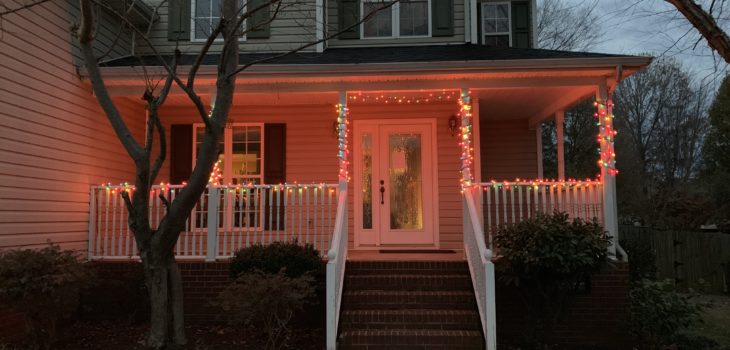
Front porches as metaphor might help us connect with…
From front porches to backyard fences, we are changing how we relate to people.
I don’t remember who was talking about it – I have too many conversations with people about too many topics. But we were talking about how neighborhoods changed when front porches declined and backyards became a thing. I’m thinking it also is changing how we related to people.
Front porches preferred
Used to be, people used their front porches for more than decoration. On hot summer evenings, people would sit on the front porch to enjoy the cooler air (houses weren’t air conditioned) and visit. They would talk to each other and to those who passed by on the sidewalk. Neighbors knew each other. There were more than mere nods that pass for acknowledgment today.
Living in Tennessee, I notice many houses have big front porches. Often, they have nice furniture — wicker chairs, slatted swings, cushions, tables, lighting – but not people. It’s too hot to sit outside during the day, and most people prefer the ever-present air conditioning anyway.
Front porches seem to be just for decoration now.
Fenced backyards for privacy
But before air-conditioning turned everyone into hermits, backyards pulled people off their porches.

In the conversation I had (someone please remind me who I was talking to about it!), it was suggested that people started using backyards to have more privacy. Rather than sit on the front porch and interact with the world, people started spending their time tucked behind their home’s façade, enclosed in their own space.
If it was fenced, well, even better. You never would need to interact with the neighbors again. You were walled in, as it were, in your own little castle.
I’ve been reading a fiction book about a castle, and I’ve read other books and seen movies depicting castle life. Most castles were bustling places. In addition to the family who lived there, servants and a multitude of guests called it home. They really were like small cities, in a way. You didn’t have much solitude living in a castle community.
And yet, we seem to seek it out now. We want our own space, our own house or home, maybe with a backyard and a fence.
Are we looking to keep people out? Or keep ourselves in?
If you have a backyard barbecue, are you likely to invite the neighbors? Or just family and friends? Do we entertain at all? Or are we so shut off that we just go about our own business entirely?
Reach out
I had a conversation with a friend recently about reaching out to people. We both feel – sometimes anyway – that we are the ones who reach out to others. We noted that we both have friends and family who won’t call us – we always have to be the ones to reach out first.
I’m not sure if this is a personality trait in us or others.
Rather than let it bother me, I recognize if I want to see someone, I need to make it happen. Priority is key.
Think about this. You are at the grocery store and run into someone you haven’t seen in a while. It’s someone you’d like to spend time visiting, and you both agree you should get together.
And that’s it. The next time you see that person, it’s months later at another event, and again you agree you should get together.
With me, if I really want to see that person, I’ll make it a priority. Rather than say, “Let’s get together sometime,” I say, “Get out your calendar, and let’s pick a date.” Often, I’m met with an incredulous look. “If we don’t schedule it, it won’t happen,” I explain. And because we’ve all done it, the other person agrees, and we actually set a time to get together.
And then we get together and agree it was pleasant and that we really need to do it again.
Connect with others
If it’s difficult for us to connect with the people we know and like, how much more difficult is it for us to connect with people we don’t know, who are strangers or nearly so?
Trading front porches for fenced backyards turns us more into ourselves.
Maybe that’s not a bad thing. But for social creatures, people who rely on others for companionship, friendship and love, it’s curious.
I’m of both minds, I guess. I enjoy my solitude. The backyard with a fence is a comforting place. But meeting new people on the front porch can be exciting, and you never know what sort of friendship might be sparked by reaching out. Front porches as a metaphor might help us connect.
How to Be a Better Writer Tip
Find a balanced level of description
I mentioned that I’ve been reading a work of fiction that includes castle life. The writing is a bit flowery, in my opinion. Readers get a lot of detail about how things smell, what they look like, where they are located. I understand the importance of painting a picture with words. It helps place your reader in your world. But this book seems a little too littered with excess language.
I’ve learned to skim certain passages, because I know it’s just going to be description.
My journalism background causes me to write with a lot of exposition. I want to explain things simply. Provide the details, then move on. This is great for a news story. Not so much for a novel.
Writing sometimes requires more description. The author needs to set the scene and draw you in. Simply providing the background won’t work.
Somewhere between my preferred writing style and that of the author I’m reading now is likely a happy medium.
As you consider what you’re writing, think about how much description you need. Does the color of your protagonist’s shirt matter? What about the color of his eyes?
There’s no right or wrong answer – unless you go too far one way or the other. You don’t want to distract your reader with too much description, but you don’t want your writing to be so bare that there’s no decoration.
You might find your preferred level of description by thinking about your favorite book or author. Chances are, that book or writer achieves the level of description you enjoy the most. Think about the words in that book or by that author. Is it excessively descriptive, sparse or somewhere in the middle?
Then, consider your writing. Is it overly descriptive, too bare or just right?




5 COMMENTS
Excellent article, Mystique! Connecting with people is so important and I love front porches, both for connecting and for curb appeal. Sadly, so many live in the social media walls of solitude these days that your article may very well be a new and exciting idea.
Thank you, Jane. Social media solitude is a great way to describe it and good fodder for another post!
I’m particularly concerned about the younger generations who sit in their homes or their parents’ homes on social media and don’t connect with live people. Communication and non-verbal communication are greatly impacted. Plus the sheer lives of quiet desperation….does it lead to loneliness? No hope? No love? No learning or growing or connecting with others? And then, where does this lead to? Follow the path and its a bit scary….
I certainly think the loss of front porches social interaction is sad. I loved when I walked around Schellsburg PA and everyone waved and called out to me. Total strangers and yet nearly every house had people sitting outside who interacted with me. I have noticed down here in TN, in some of the areas outside of town, people are on their front porches, even on hot days, and if you glance over as you drive by, THEY WAVE! Amazing!
Joey and I love to sit on our tiny front porch, and sometimes neighbors even stop on the road, which is some distance away, and will call out to us, or next door neighbors will stop for a moment if they are outside and see us.
I think there is a place for both backyard privacy and front porches, but either way, socialization is much more needed today with everyone’s head stuck in a call phone. I am glad porches are something that is coming back into fashion on the newer homes. Whether people will actually use them much, I do not know, but I hope so!
Not too long ago I was making a regular late afternoon run through some suburbs of Boston and I realized I passed within sight of thousands of housing units which have front porches or balconies and I saw not one person using one. It was a nice enough afternoon and it was late enough in the day that a lot of people would have been home.
I basically came to the conclusion that it is considered déclassé to be seen sitting on your front porch. People don’t want to be seen goofing off. It’s something that might be considered acceptable among the lower classes but not among the middle class or above.
I think back to my own grandparents who had a quite large front porch with Roman columns and a wooden porch swing. I don’t remember them once ever using that front porch for anything, and in fact they later tore it down and replaced it with a larger enclosed entryway. They built a second porch off the back of their house. This begs the question, why replace one porch with another? I think they didn’t want to be seen socializing and entertaining on their front porch. Basically nobody could see them on their back porch without really trying to.
In my own life, I have had several porches and patios that face the streets and which I basically only used for decoration. I even bought some patio furniture for it that I never had any intention of using. In fact, I used that patio furniture exactly once a year when I carved a pumpkin out there.